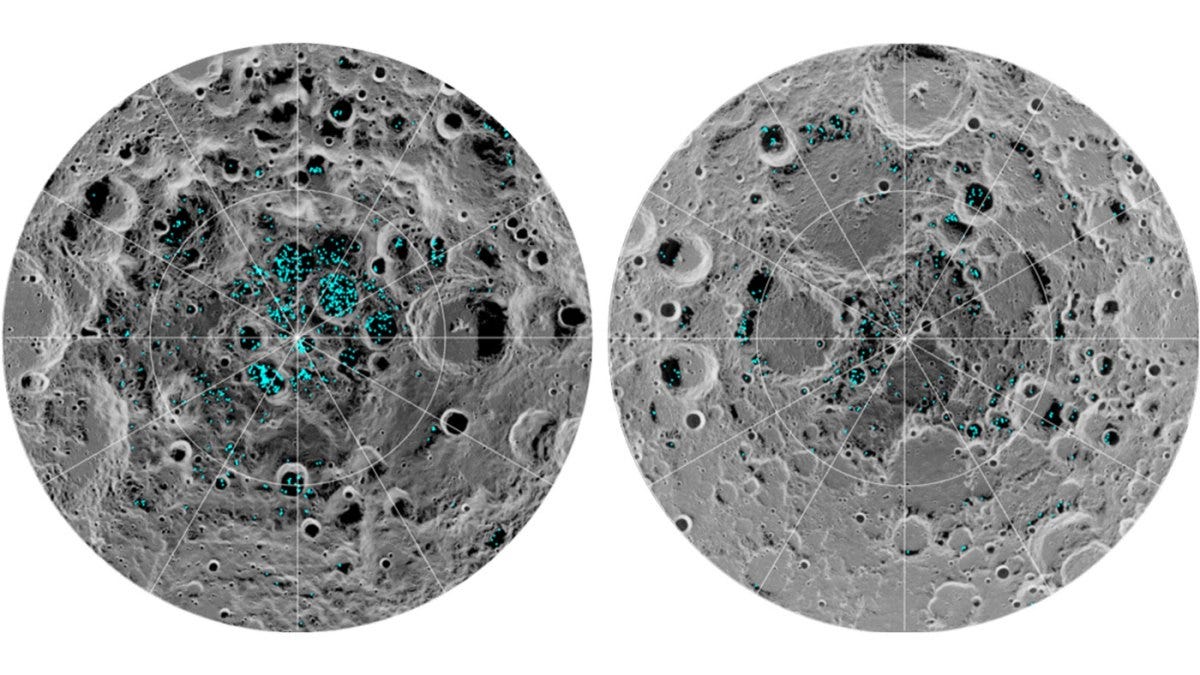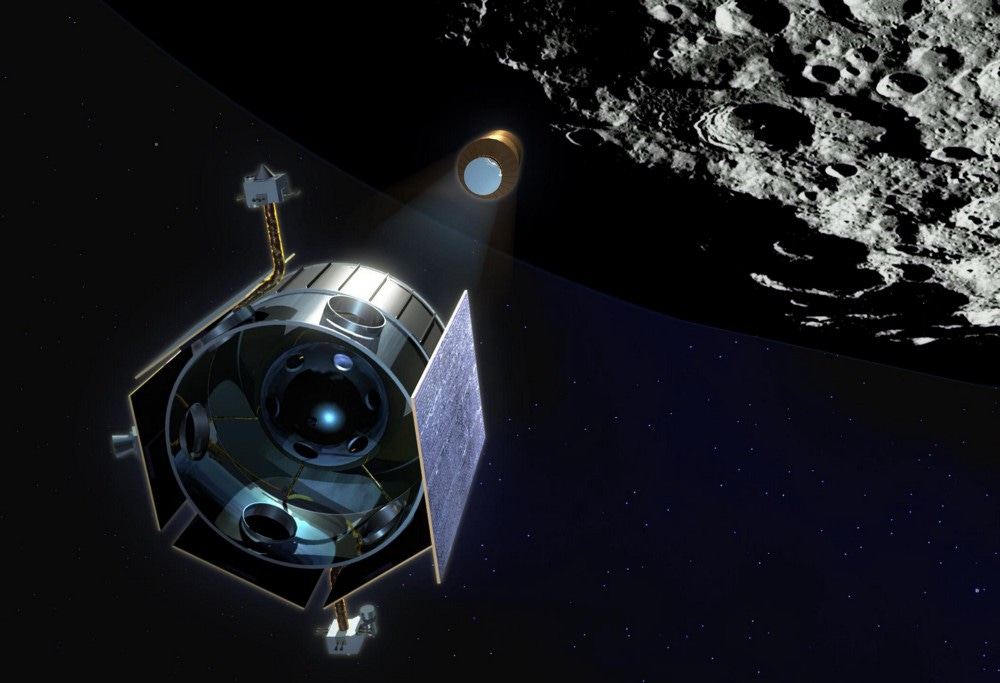How NASA and India discovered water on our Moon
The story of finding water on the Moon spans at least two decades and multiple space agencies, culminating in renewed lunar exploration plans across the world.
For most of the 20th century, scientists thought the Moon’s surface was bone-dry. The 382 kilograms of rock and soil samples brought by the Apollo missions to Earth attested to this. When they did find traces of water in the samples, scientists dismissed them as terrestrial contamination. After all, any water on the Moon’s surface would quickly evaporate due to being directly exposed to the vacuum of space. And due to the Moon’s low gravity, the water vapor would quickly escape into space.
However, there are certain regions on the Moon that haven’t received sunlight for over a billion years, and where scientists think the water can be. On the lunar poles, the Sun is very close to the local horizon throughout the day so even a small feature, like a rock, can cast very long shadows. Likewise, large craters with terraced edges can easily block sunlight from entering the crater from any direction. Scientists call such places permanently shadowed regions, or PSRs, because they’re eternally dark. They’re also really cold, making them apt to preserve water in the form of ice.

But where would the water come from?
Scientists know that comets and many types of asteroids contain water. For a large part of our solar system’s existence, these objects have been continually bombarding planets and their moons. This is why the Moon is covered in craters, and scientists think the asteroids and comets responsible for them could have deposited water on the Moon. While most of the water must have evaporated, some fraction of it could’ve found its way into PSRs on the lunar poles, where, like sitting inside a refrigerator, they can stay preserved for billions of years.
In 1994, NASA launched the Clementine lunar orbiter. Its Bistatic Radar Experiment beamed radio signals straight into the PSRs. The signals bounced off the PSRs and were received by ground stations on Earth. Scientists found the nature of the reflected signals to be consistent with water ice but the data wasn’t conclusive.
NASA sent another orbiter in 1998, called the Lunar Prospector, to find out if the Moon was hiding water ice deposits. Its neutron spectrometer found that the nature of neutrons in the soil of many PSRs corresponded with the presence of hydrogen atoms. Could these hydrogen atoms be part of water molecules?
Armed with Clementine and Lunar Prospector data, scientists were almost certain that there must be water on the Moon but they needed to be absolutely sure.
Water on the Moon indeed
In 2008, India forayed into planetary exploration with the launch of their Chandrayaan 1 lunar orbiter, for which ISRO solicited instruments from scientists around the world. NASA pitched and built two of these, named Mini-SAR and M3.
The Miniature Synthetic Aperture Radar (Mini-SAR) also found that the PSRs reflected signals in patterns consistent with water ice, from more than 40 polar craters. But just like with Clementine, they couldn’t be 100% certain with the data at hand.

The Moon Mineralogical Mapper (M3), an infrared spectrometer, would go on to clinch the prize. M3 detected not just water in the PSRs but could also differentiate between ice, liquid water, and water vapor based on how the surface absorbed infrared light. M3 confirmed that the Moon hosted water once and for all.

The Chandrayaan 1 orbiter also carried an impact probe—a craft that intentionally crashed near a PSR on the Moon’s south pole. As it descended, its mass spectrometer purportedly detected water molecules in the thin but present lunar atmosphere. However, ISRO didn’t publish the results until NASA announced that Mini-SAR and M3 had discovered lunar water. ISRO then claimed that their instrument had detected water on the Moon first.
Not that dry
All this time, scientists had been developing ideas about how the Moon could host water in its other parts as well, not just near or on its poles. The Moon is constantly bombarded by the stream of protons coming from the Sun, some of which its surface absorbs. Scientists thought the oxygen in the lunar soil could interact with the absorbed protons to produce water, and that they should be able to detect such water molecules from orbit. Likewise, incessant bombardment by micrometeorites on the lunar surface could also deliver or produce water.
NASA’s Cassini spacecraft flew by the Moon in 1999, en route to Saturn. Its infrared spectrometer found water-bearing minerals at most latitudes on the Moon, with higher concentrations at the poles. The results were in stark contrast to the bone-dry Apollo samples. One reason could be that since most Apollo landing sites were near the equator, high daytime temperatures might have evaporated any water present. However, the team didn’t publish their findings until the Chandrayaan 1 discovery a decade later.

The European Space Agency’s instrument onboard Chandrayaan 1, SARA, analyzed protons reflected by the lunar surface. Like Cassini, SARA found water/hydroxyl groups in the lunar soil. The discovery proved timely for ESA’s BepiColombo mission to study Mercury, which carries two similar instruments for detecting water. Chandrayaan 1’s M3 instrument detected water and hydroxyl molecules almost everywhere on the Moon too.
All of these observations had one catch—it was impossible to tell if what the instruments detected was water (H2O) or just hydroxyl groups (OH) bound to minerals. NASA and the Germany space agency’s airborne SOFIA telescope could distinguish between the two. In 2020, it confirmed the presence of water molecules, as in H2O, on the Moon’s surface in non-polar regions.
Scientists now knew that the lunar soil does hold trace amounts of water even in non-polar regions. Note that it’s still less water than the driest deserts on Earth. However, the PSRs on the lunar poles host appreciably more water.
LRO and Chandrayaan 2
In 2009, NASA launched the Lunar Reconnaissance Orbiter (LRO). It also detected water ice on the Moon’s poles using the onboard radar, ultraviolet detector as well as the neutron spectrometer. LRO has been orbiting the Moon for over a decade now, longer than any other orbiter. The LRO team has published an extensive atlas of PSRs, laying the groundwork for future exploration and settlement on the Moon.
Like Chandrayaan 1’s impact probe, LRO carried an impactor too, called LCROSS. In 2009, its upper stage deliberately impacted one of the PSRs on the Moon’s south pole. The other half of LCROSS followed and studied the plume of moondust the crash kicked up. It was found to contain 155 kilograms of water.


Using this result and other observations, scientists estimated all the PSRs together must host at least 600 billion kg of water ice, equivalent to 240,000 Olympic-sized swimming pools.
India’s Chandrayaan 2 orbiter, orbiting the Moon since 2019, intends to extend our knowledge of water on the Moon. Its enhanced infrared spectrometer will build a global, high-resolution map of water concentrations in the lunar soil, and also determine the specific water-bearing minerals present. With Chandrayaan 2’s long-term observations, scientists want to learn how the lunar soil’s water content changes in response to changes in the lunar environment. The orbiter’s upgraded radar will better map the water ice in the PSRs. With twice as much penetration depth and higher resolution, it will quantify the amount of accessible water trapped in these cold regions, something no one has adequately done yet.
Living on the Moon awaits
The story of finding water on the Moon spans at least two decades and multiple space agencies, culminating in renewed lunar exploration plans across the world. The lunar science and exploration communities agree that we can harness water ice on the Moon for future habitat needs. Using solar power generated by the habitats, we can also split the water ice into hydrogen and oxygen to use as rocket fuel. But before we plan habitats on the Moon, we need to know more about the exact nature of its water ice.
Surface missions that explore PSRs up-close, like NASA’s upcoming VIPER rover, are the next logical step towards building sustainable habitats on the Moon. It will physically study and map water ice deposits to not only inform us how we can extract the water to sustainably live on the Moon but also provide insights into the history and origin of water in the inner solar system, including Earth.
In the long run, as we develop technologies to harness water ice, we can not just settle on the Moon but across the solar system. We should be glad our nearest neighbor has plenty of water; we can’t keep dragging everything out of Earth’s gravitational pull for eternity.
Originally published at The Wire in 2019, significantly revised in 2021 and 2022 to accommodate new discoveries and developments.
→ Browse the Blog | About | Donate ♡
